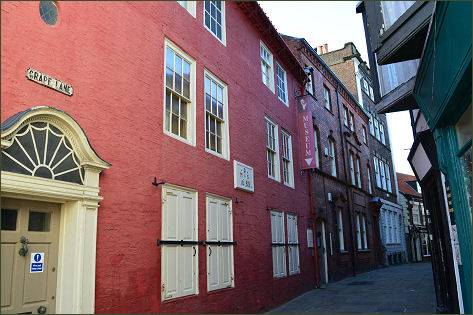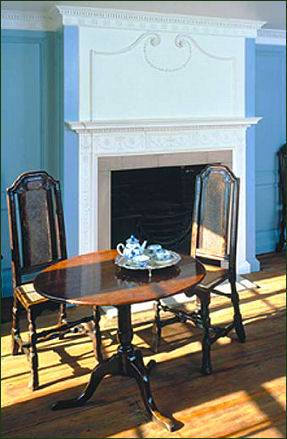Captain Cook Memorial Museum, Whitby
 The interesting Captain Cook Museum is housed in an historic building in Grape Lane on the harbourside at Whitby.
The interesting Captain Cook Museum is housed in an historic building in Grape Lane on the harbourside at Whitby.
James Cook was born on 27 October 1728 at the village of Marton-in-Cleveland and baptised on 3 November in the parish church of St Cuthbert, where his name can be seen in the church register. He was the son of James Cook, a Scottish farm labourer and Grace Pace, who was of Yorkshire extraction.
When James was still a child, his father moved to Airey Holme farm, Great Ayton in the North York Moors. In 1745, when he was 16, Cook moved 20 miles (32 km) to the fishing village of Staithes, to be apprenticed as a shop boy to grocer and haberdasher William Sanderson. Historians have speculated that this is where Cook first felt the lure of the sea.
In 1746, then a young man of seventeen, Cook came to Whitby to be apprenticed to Captain John Walker to whom he was introduced by his employer, grocer and haberdasher William Sanderson. John Walker and his brother Henry were Quaker shipowners engaged in the coal trade between the North-East and London. Cook served Walker first as apprentice, then as seaman and lastly as master's mate until he joined the Royal Navy in 1755.
 A characterul seventeenth century house, the museum is the sole surviving building which can be connected to Cook, according to long-standing Whitby tradition, Walker lodged Cook in the attic of the house in Grape Lane, with other apprentices when not at sea. Whitby historian George Young described Cook studying in the attic with the aid of candles provided by Mary Prowd, a family servant. Much is known about the furnishings of the house from an inventory of contents taken in 1754. The two ground floor rooms are furnished according to this inventory and decorated in the original colour.
A characterul seventeenth century house, the museum is the sole surviving building which can be connected to Cook, according to long-standing Whitby tradition, Walker lodged Cook in the attic of the house in Grape Lane, with other apprentices when not at sea. Whitby historian George Young described Cook studying in the attic with the aid of candles provided by Mary Prowd, a family servant. Much is known about the furnishings of the house from an inventory of contents taken in 1754. The two ground floor rooms are furnished according to this inventory and decorated in the original colour.
Built in 1688 by Moses and Susannah Dring, it is a large building on three floors with an attic. The house is a good example of a Whitby master-mariner's dwelling, both a comfortable home and the centre of the family shipping business. It retains much of its original internal decoration and has been carefully restored. The atmosphere recalls that of a prosperous Quaker shipowner's home. It was well constructed, with skilled craftsmanship seen for example in the panelling, doors and staircase, but without any display or extravagance. The colours are based on the original ones, and create an impression of calm restfulness.
The visitor enters from the courtyard overlooking the harbour, which now contains an attractive garden planted with eighteenth century type plants. Passing through the Orientation Room and the former kitchen, the ground floor rooms are furnished according to an inventory made in the early 1750s. The upper floors follow Cook's life and career from Whitby to Canada, through the great Voyages to the 'Ends of the Earth'. Visitors can letters in Cook's own handwiting, original paintings and drawings, ship models and maps, and strange objects from newly discovered lands. From the bleak Antarctic Ocean to the fertile beauty of Pacific islands, all Europe was fascinated by the images and objects brought back.
Free house guide (in 6 languages). Free Activities Sheet for children. Gift Shop'
